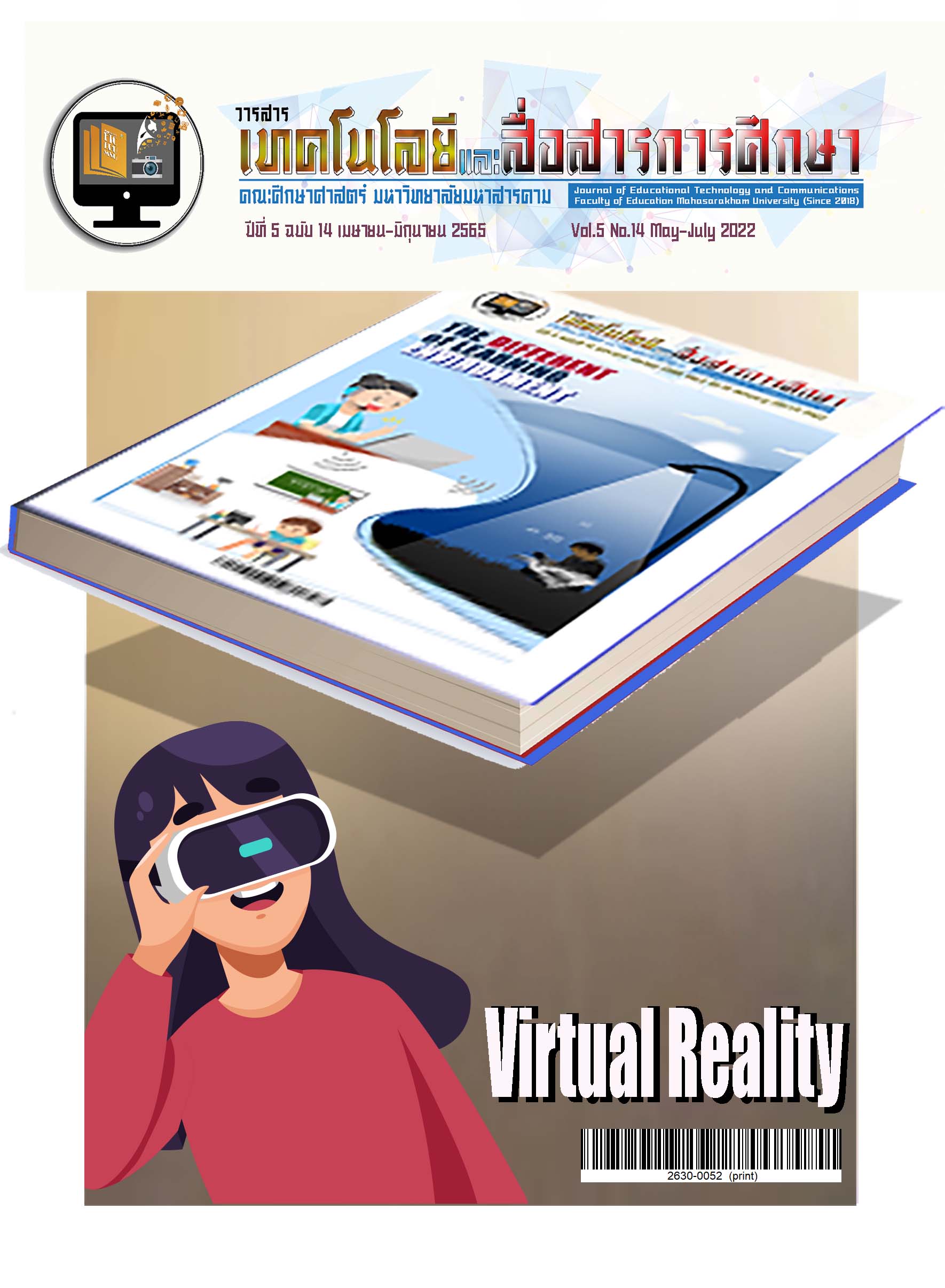การพัฒนาองค์ประกอบและตัวชี้วัดการเรียนรู้แบบกำกับตนเองในการเรียนออนไลน์ ของนิสิตนักศึกษาครูในสถาบันอุดมศึกษา
Main Article Content
บทคัดย่อ
การวิจัยในครั้งนี้มีวัตถุประสงค์เพื่อ 1) ศึกษาองค์ประกอบและตัวชี้วัดการเรียนรู้แบบกำกับตนเอง ในการเรียนออนไลน์ของนิสิตนักศึกษาครูในสถาบันอุดมศึกษา และ 2) ตรวจสอบความตรงเชิงโครงสร้างของ องค์ประกอบและตัวชี้วัดการเรียนรู้แบบกำกับตนเองในการเรียนออนไลน์ของนิสิตนักศึกษาครูในสถาบันอุดมศึกษา กลุ่มตัวอย่างเป็นนิสิตนักศึกษาครูในสถาบันอุดมศึกษา รวมทั้งสิ้น 1,440 คน ที่ได้มาจากการสุ่มแบบหลายขั้นตอน (Multi-stage Random Sampling) เครื่องมือที่ใช้ในการวิจัยเป็นแบบสอบถามมีลักษณะเป็นมาตรประมาณค่า 5 ระดับ สถิติที่ใช้ในการวิเคราะห์ข้อมูล ได้แก่ ความถี่ ร้อยละ ค่าเฉลี่ย ส่วนเบี่ยงเบนมาตรฐาน การวิเคราะห์ องค์ประกอบเชิงสำรวจ และการวิเคราะห์องค์ประกอบเชิงยืนยัน
ผลการวิจัยพบว่า
1. องค์ประกอบและตัวชี้วัดการเรียนรู้แบบกำกับตนเองในการเรียนออนไลน์ของนิสิตนักศึกษาครู ในสถาบันอุดมศึกษา มี 4 องค์ประกอบ 25 ตัวชี้วัด ได้แก่ การจัดการเวลาในการเรียน (7 ตัวชี้วัด) การรับรู้ ความสามารถของตนเองและการขอความช่วยเหลือในการเรียน (7 ตัวชี้วัด) การตั้งเป้าหมายในการเรียน (6 ตัวชี้วัด) และการจัดสภาพแวดล้อมในการเรียน (5 ตัวชี้วัด) โดยองค์ประกอบทั้งหมดสามารถอธิบาย การเรียนรู้แบบกำกับตนเองในการเรียนออนไลน์ได้ร้อยละ 64.39
2. องค์ประกอบและตัวชี้วัดการเรียนรู้แบบกำกับตนเองในการเรียนออนไลน์ของนิสิตนักศึกษาครูในสถาบันอุดมศึกษามีความสอดคล้องกับข้อมูลเชิงประจักษ์ (Chi-square=202.257, df=186, p-value=0.062, RMSEA=0.021, CFI=0.993 และ SRMR=0.035) และมีความตรงเชิงโครงสร้าง ซึ่งพิจารณาได้จากค่าน้ำหนัก องค์ประกอบที่มีนัยสำคัญทางสถิติที่ระดับ .01 ทุกตัวชี้วัด โดยน้ำหนักองค์ประกอบมีค่าอยู่ระหว่าง 0.345 ถึง 0.796
Downloads
Article Details
เอกสารอ้างอิง
ธานินทร์ อินทรวิเศษ, ธนวัฒน์ เจริญษา, และพิชญาภา ยวงสร้อย. (2564). ภาพสะท้อนการศึกษาไทยหลังภาวะโควิด 2019. วารสารการบริหารนิติบุคคลและนวัตกรรมท้องถิ่น. 7(4), 323-333.
เนาวนิตย์ สงคราม. (2563). การจัดการเรียนการสอนและการประเมินผลผู้เรียนแบบออนไลน์ภายใต้สถานการณ์ และมาตรการการป้องกันการแพร่ระบาดของเชื้อไวรัสโคโรนา 2019. สำนักบริหารวิชาการและศูนย์นวัตกรรมการเรียนรู้, จุฬาลงกรณ์มหาวิทยาลัย.
ประกาศกระทรวงการอุดมศึกษา วิทยาศาสตร์ วิจัยและนวัตกรรม. (2562). มาตรการและการเฝ้าระวังการระบาดของโรคติดต่อเชื้อไวรัสโคโรนา 2019 (COVID-19) (ฉบับที่ 11) พ.ศ. 2562. https://www.mhesi.go.th/images/Pusit2021/pdfs/CCF_000006.pdf
ประกาศกระทรวงการอุดมศึกษา วิทยาศาสตร์ วิจัยและนวัตกรรม เรื่อง กำหนดปรัชญาการอุดมศึกษาไทยและระดับอุดมศึกษาใหม่ ด้านการสร้างบัณฑิตและพัฒนากำลังคน, 2564. (2564, 27 พฤษภาคม). ราชกิจจานุเบกษา. เล่มที่ 138 ตอนพิเศษ 144 ง, หน้า 2.
ประกาศกระทรวงศึกษาธิการ เรื่อง มาตรฐานคุณวุฒิระดับปริญญาตรีสาขาครุศาสตร์และสาขาศึกษาศาสตร์ (หลักสูตร 4 ปี) พ.ศ. 2562. (2562, 6 มีนาคม). ราชกิจจานุเบกษา. เล่มที่ 136 ตอนพิเศษ 56 ง, หน้า 12-39.
ประกาศคณะกรรมการคุรุสภา เรื่อง รายละเอียดของมาตรฐานความรู้และประสบการณ์วิชาชีพครู ตามข้อบังคับคุรุสภา ว่าด้วยมาตรฐานวิชาชีพ (ฉบับที่ 4) พ.ศ. 2562. (2563, 7 พฤษภาคม). ราชกิจจานุเบกษา. เล่มที่ 137 ตอนพิเศษ 109 ง, หน้า 10-14.
มูลนิธิคีนันแห่งเอเชีย. (2563, 30 เมษายน). การแพร่ระบาดของโควิด-19 สร้างผลกระทบต่อการศึกษาไทยที่สำคัญ 3 ประการ. https://www.kenan-asia.org/th/covid-19-education-impact
มหาวิทยาลัยพะเยา. (2563, 24, กรกฏาคม). ประกาศมหาวิทยาลัยพะเยา เรื่อง แนวทางการจัดการเรียนการสอนและการวัดและประเมินผล ภาคการศึกษาต้น ปีการศึกษา 2563 (ฉบับที่ 2). https://up.ac.th/th/NewsReadAnnounce.aspx?itemID=21972
วิจารณ์ พานิช. (2555). วิถีสร้างการเรียนรู้เพื่อศิษย์ในศตวรรษที่ 21. มูลนิธิสดศรี-สฤษดิ์วงศ์.
สาลินี จงใจสุธรรม, นำชัย ศุภฤกษ์ชัยสกุล, และวินัย ดำสุวรรณ. (2558). กลวิธีการกำกับตนเองในการเรียนรู้ในศตวรรษที่ 21. วารสารพฤติกรรมศาสตร์เพื่อการพัฒนา, 7(1), http://ejournals.swu.ac.th/index.php/ jbsd/article/view/5129
สิริพร อินทสนธิ์. (2563). โควิด-19 : กับการเรียนการสอนออนไลน์ กรณีศึกษารายวิชาการเขียนโปรแกรมเว็บ. วารสารวิทยาการจัดการปริทัศน์, 22(2), 203 – 214.
สำนักงานเลขาธิการสภาการศึกษา. (2563). รายงาน เรียนออนไลน์ยุคโควิด-19 : วิกฤตหรือโอกาสการศึกษาไทย. สำนักมาตรฐานการศึกษาและพัฒนาการเรียนรู้, สำนักงานเลขาธิการสภาการศึกษากระทรวงศึกษาธิการ.
Alhazbi, S., & Hasan, M. A. (2021). The Role of Self-Regulation in Remote Emergency Learning: Comparing Synchronous and Asynchronous Online Learning. Sustainability, 13(19),
https://www.mdpi.com/2071-1050/13/19/11070
Artino, A. R. (2009). Online learning: Are Subjective Perceptions of Instructional Context Related to Academic Success? Internet and Higher Education, 12(3-4), DOI:10.1016/j.iheduc.2009.07.003 https://www.researchgate.net/ publication/257495977_Online_learning_Are_subjective_perceptions_of_instructional_context_related_to_academic_success
Bakar, Z. A., Yun, L. M., Keow, N. S., & Li, T. H. (2014). Goal-Setting Learning Principles: A Lesson from Practitioner. Journal of Education and Learning, 8(1), https://www.semanticscholar.org/paper/Goal-Setting-Learning-Principles%3A-A-Lesson-From-Bakar-Yun/1fa18f077b8db2f3b99b31e77057b20b03050356
Barnard, L., Lan, W. Y., To, Y. M., Paton, V. & Lai, S. (2009). Measuring Self-regulation in Online and Blended Learning Environments. Internet and Higher Education, 12(1), DOI:10.1016/j.iheduc.2008.10.005 https://www.researchgate. net/publication/223619785_Measuring_self-regulation_in_online_and_blended_learning_environments
Cho, M.-H., & Jonassen, D. (2009). Development of the Human Interaction Dimension of the Self-regulated Learning Questionnaire in Asynchronous Online Learning Environments. Educational Psychology, 29(1), https://doi.org/10.1080/01443410802516934
Cho, M.-H., & Kim, B. J. (2013). Students’ Self-regulation for Interaction with Others in Online Learning Environments. Internet and Higher Education, 17, https://experts.syr.edu/en/publications/students-self-regulation-for-interaction-with-others-in-online-le
Cho, M., & Shen, D. (2013). Self-regulation in Online Learning. Distance Education, 34(3), https://doi.org/10.1080/01587919.2013.835770
Gilbert, B. (2015). Online Learning Revealing the Benefits and Challenges. St. John Fisher College. https://fisherpub.sjfc.edu/cgi/viewcontent.cgi?article=1304&context=education_ETD_masters
Hair, J. F., Black, W. C, Babin, B. J., Anderson, R. E. (2009). Multivariate Data Analysis (7th ed). Upper Saddle River, NJ: Pearson Prentice Hall.
Hair, J. F., Anderson, R. E., Babin, B. J., & Black, W. C. (2010). Multivariate Data Analysis: A Global Perspective. Upper Saddle River, NJ: Pearson.
Hrastinski, S. (2009). A Theory of Online Learning as Online Participation. Computer & Education, 52(1), 78-82.
Heikonen, L., Toom, A., Pyhältö, K., Pietarinen, J., & Soini, T. (2017). Student-teacher’s Strategies in Classroom Interaction in the Context of the Teaching Practicum. Journal of Education for Teaching, 20, 1-16.
Kaplan, D., (2000). Structural Equation Modeling. California: Sage Publications.
Karabenick, S. A., & Gonida, E. N. (2018). Academic Help Seeking as a Self-regulated Learning Strategy: Current Issues, Future Directions. In D. H. Schunk & J. A. Greene (Eds.), Handbook of Self-regulation of Learning and Performance (pp. 421–433).
Lin, J. (2018). Effects of an Online Team Project-based Learning Environment with Group Awareness and Peer Evaluation on Socially Shared Regulation of Learning and Self-regulated Learning. Behaviour & Information Technology, 37(5), 445-461.
Nicholls, J. G. (1984). Achievement motivation: Conceptions of Ability, Subjective Experience, Task Choice, and Performance. Psychological Review, 91(3), 328–346.
Pichardo, C., Justicia, F., Fuente, J., Martínez-Vicente, J. & Berbén, A. B. G. (2014). Factor Structure of the Self-regulation Questionnaire (SRQ) at Spanish Universities. Spanish Journal of Psychology, 17, 1–8.
Pintrich, P. (1995). Understanding Self-regulated Learning. San Francisco: Jossey-Bass.
Pintrich, P. (2004). A Conceptual Framework for Assessing Motivation and Self-regulated Learning in College Students. Educational Psychology Review, 16(4), 385-407.
Pintrich, P. & Zusho, A. (2002). The Development of Academic Self-regulation: The role of cognitive and motivational factors. Hilldale, NJ: Erlbaum. S
aariaho, E., Anttila, H., Toom, A., Soini, T., Pietarinen, J., & Pyhältö, K. (2018). Student Teachers’ Emotional Landscapes in Self and Co-regulated Learning. Teachers and Teaching, 24(5), 538-558.
Savage, T.V., & Savage, M. K. (2010). Successful Classroom Management and Discipline: Teaching self-control and responsibility (3rd ed.). Los Angeles: SAGE Publications, Inc. T
hibodeaux, J., Deutsch, A., Kitsantas, A., & Winsler, A. (2017). First-Year College Students’ Time Use: Relations with Self-Regulation and GPA. Journal of Advanced Academics, 28(1), 5–27.
Winne, P. H. (1997). Experimenting to Bootstrap Self-regulated Learning. Journal of Educational Psychology, 89(3), 397-410.
Wolters, C. A. & Brady, A. C. (2020). College Students’ Time Management: A Self-regulated Learning Perspective. Educational Psychology Review, 33, 1319–1351.
Zimmerman, B.J. (2008). Investigating Self–regulation and Motivation: Historical Background, Methodological Developments, and Future Prospects. American Educational Research Journal, 45(1), 166-183.
Zimmerman, B. J., & Martinez-Pons, M. (1986). Development of a Structured Interview for Assessing Student Use of Self-Regulated Learning Strategies. American Educational Research Journal, 23(4), 614-628.
Zimmerman, B. J. & Martinez-Pons, M. (1990). Student Differences in Self-Regulated Learning: Relating Grade, Sex, and Giftedness to Self-Efficacy and Strategy Use. Journal of Educational Psychology, 82(1), 51-59.
Zimmerman, B. J., & Schunk, D. H. (2011). Self-regulated Learning and Performance: An Introduction and an Overview. In B. J. Zimmerman & D. H. Schunk (Eds.), Handbook of Self-regulation of Learning and Performance (pp. 1–12). New York, NY: Routledge.


